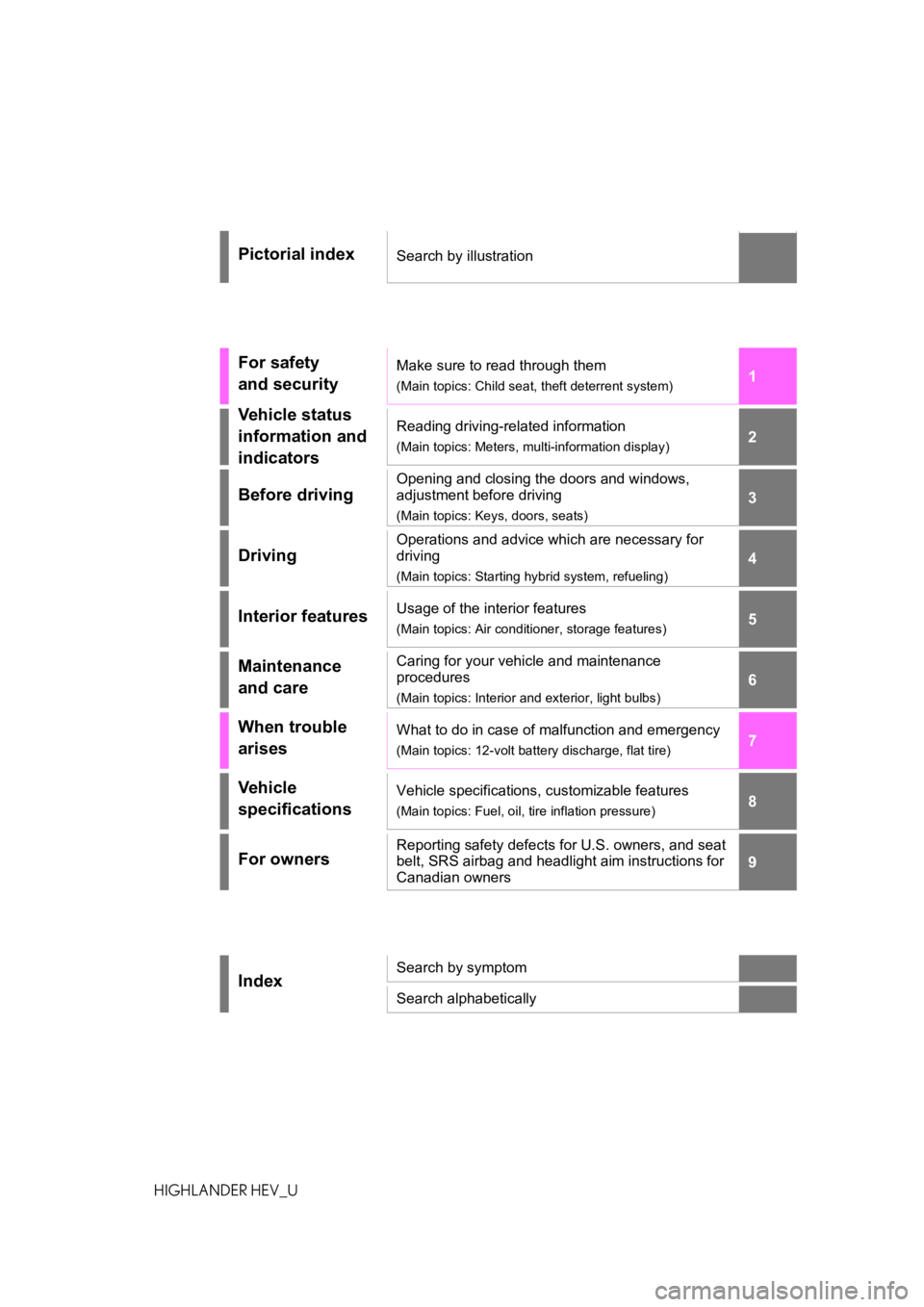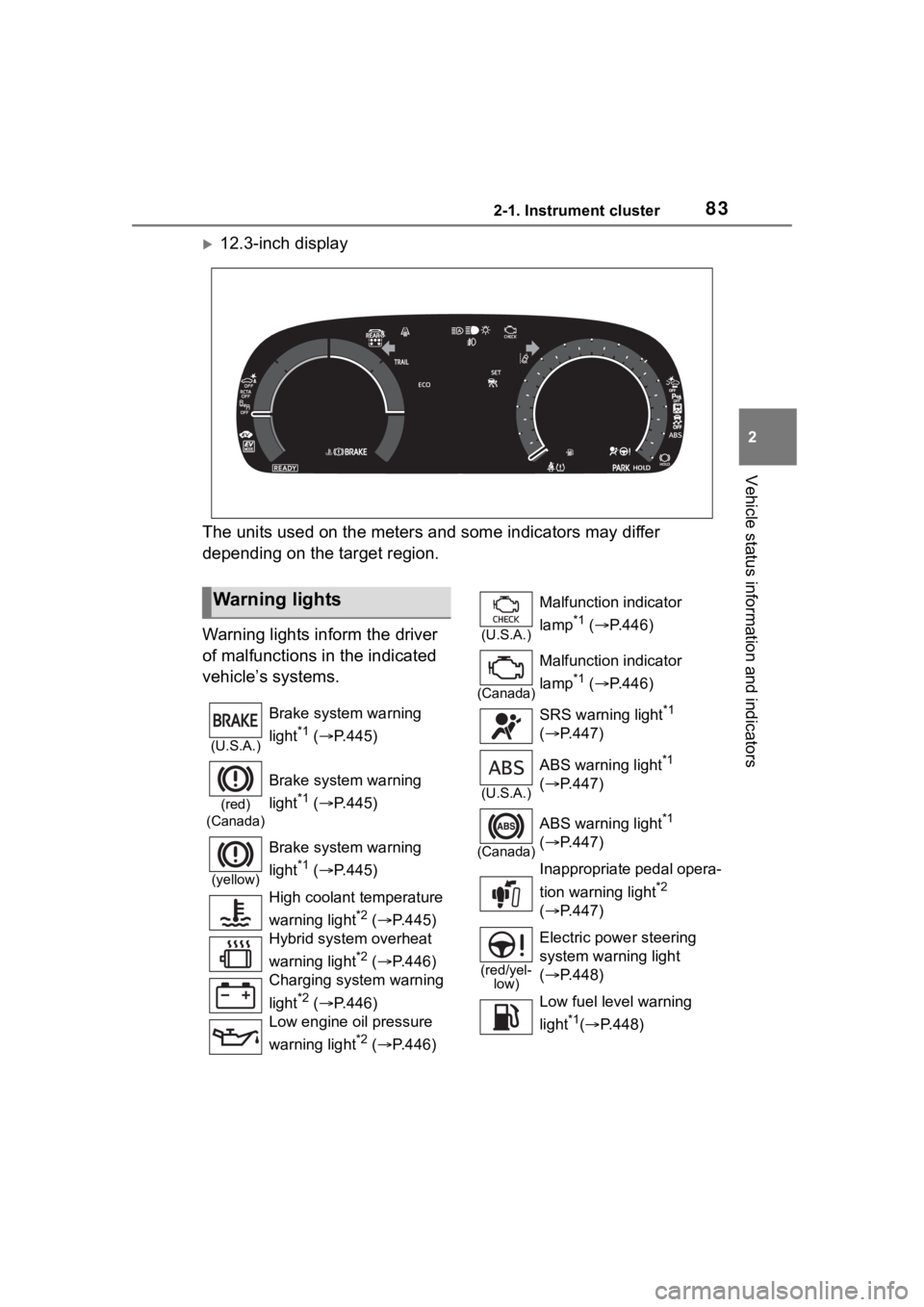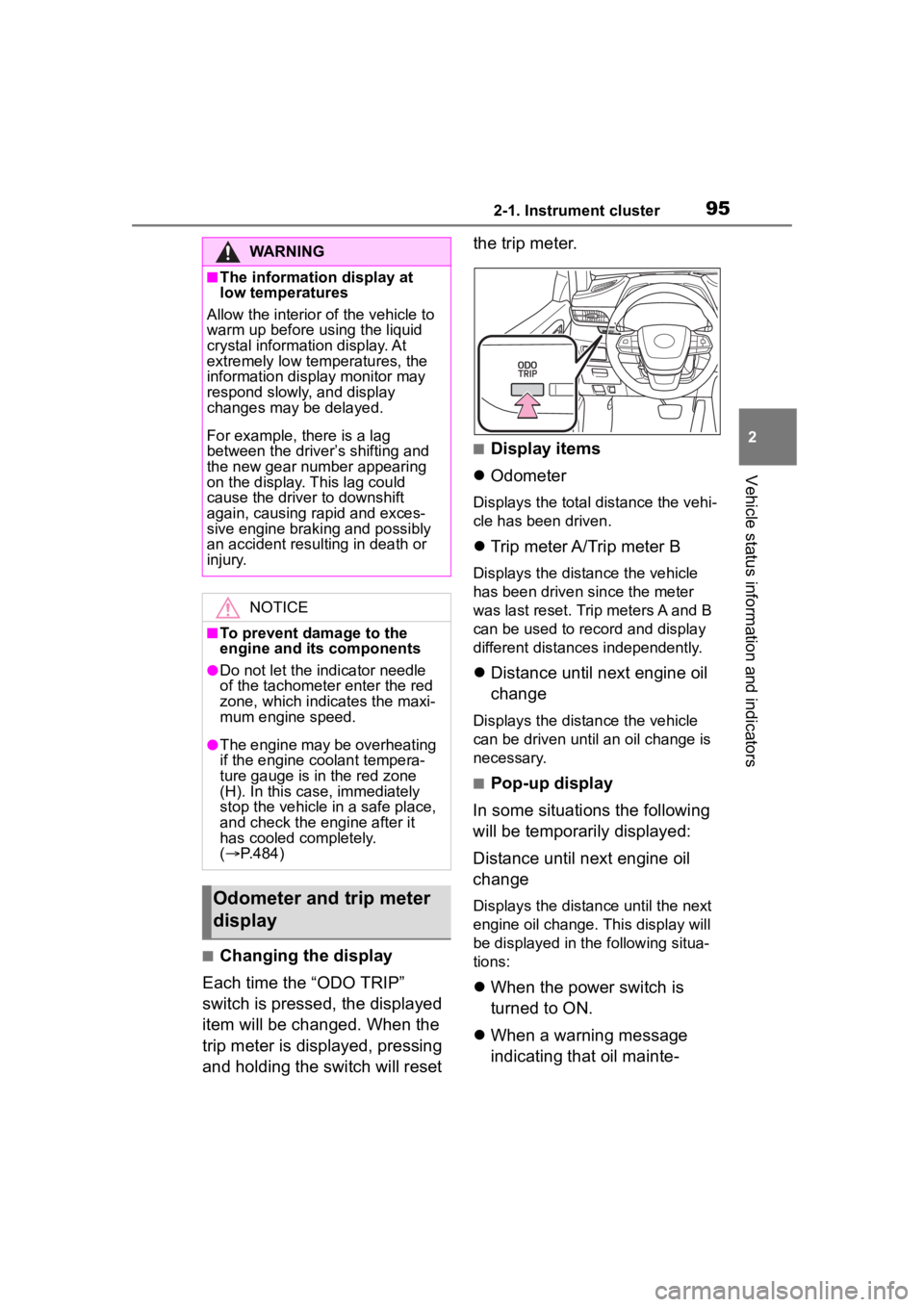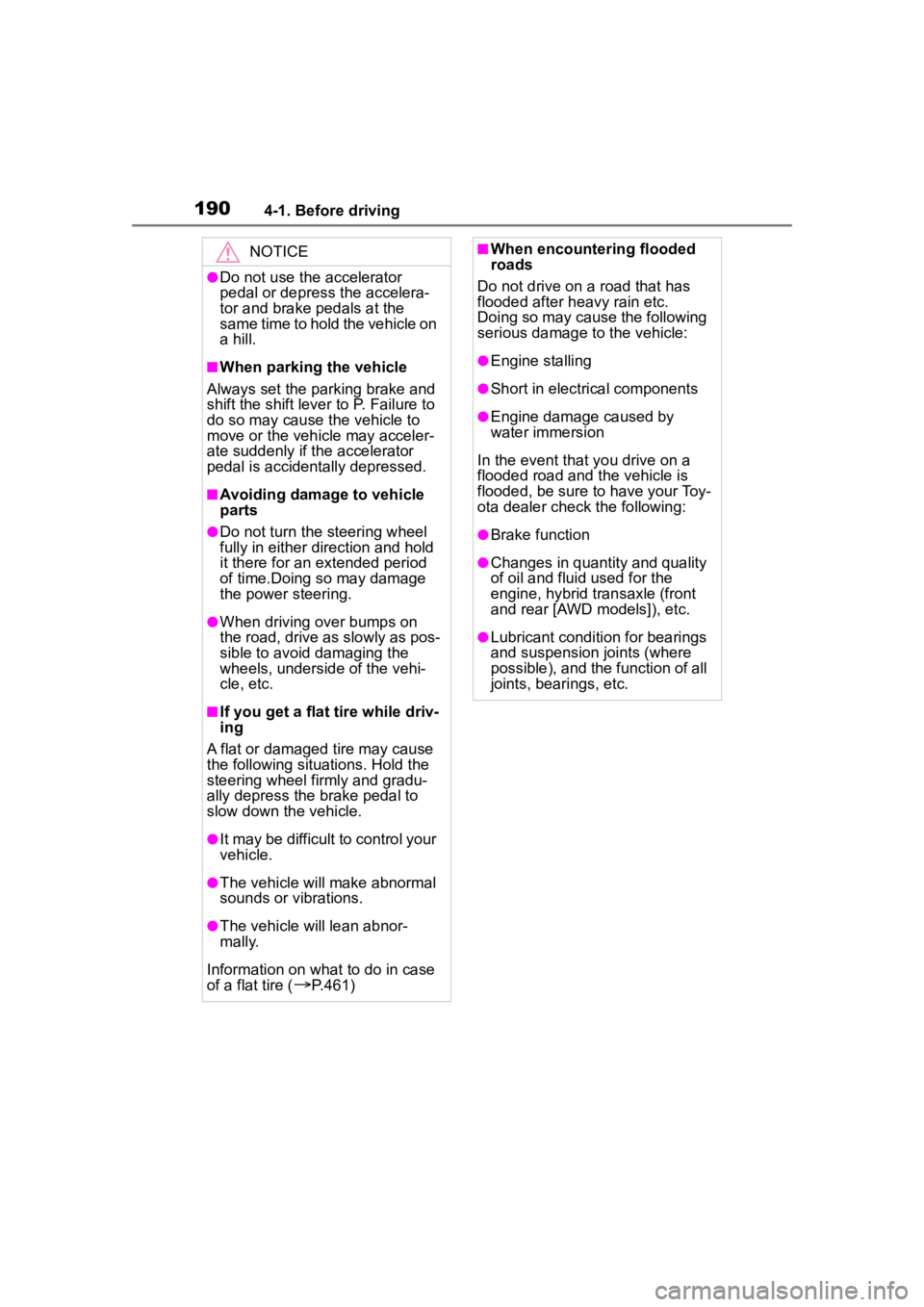oil TOYOTA HIGHLANDER HYBRID 2023 Owners Manual
[x] Cancel search | Manufacturer: TOYOTA, Model Year: 2023, Model line: HIGHLANDER HYBRID, Model: TOYOTA HIGHLANDER HYBRID 2023Pages: 572, PDF Size: 14.07 MB
Page 1 of 572

1
2
3
4
5
6
7
8
9
9
HIGHLANDER HEV_U
Pictorial indexSearch by illustration
For safety
and securityMake sure to read through them
(Main topics: Child seat, theft deterrent system)
Vehicle status
information and
indicatorsReading driving-related information
(Main topics: Meters, multi-information display)
Before driving
Opening and closing the doors and windows,
adjustment before driving
(Main topics: Keys, doors, seats)
Driving
Operations and advice which are necessary for
driving
(Main topics: Starting hybrid system, refueling)
Interior featuresUsage of the interior features
(Main topics: Air conditioner, storage features)
Maintenance
and careCaring for your vehicle and maintenance
procedures
(Main topics: Interior and exterior, light bulbs)
When trouble
arisesWhat to do in case of malfunction and emergency
(Main topics: 12-volt battery discharge, flat tire)
Vehicle
specificationsVehicle specifications, customizable features
(Main topics: Fuel, oil, tire inflation pressure)
For ownersReporting safety defects for U.S. owners, and seat
belt, SRS airbag and headlight aim instructions for
Canadian owners
IndexSearch by symptom
Search alphabetically
Page 4 of 572

4TABLE OF CONTENTS
Positioning a floor jack .......395
Engine compartment .......... 396
12-volt battery .................... 402
Tires ................................... 404
Tire inflation pressure......... 415
Wheels ............................... 417
Air conditioning filter ........... 418
Cleaning the hybrid battery (trac- tion battery) air intake vents......................................... 420
Electronic key battery ......... 423
Checking and replacing fuses ......................................... 425
Headlight aim ..................... 427
Light bulbs .......................... 428
7-1. Essential information Emergency flashers ........... 438
If your vehicle has to be stopped in an emergency .............. 438
If the vehicle is submerged or water on the road is rising
......................................... 439
7-2. Steps to take in an emergency If your vehicle needs to be towed......................................... 441
If you think something is wrong ......................................... 443
If a warning light turns on or a warning buzzer sounds .... 445
If a warning message is dis- played .............................. 456
If you have a flat tire ........... 461
If the hybrid system will not start ......................................... 474
If you lose your keys .......... 475
If the fuel filler door cannot be opened ............................. 476
If the electronic key does not operate properly ............... 477If the 12-volt battery is dis-
charged ............................ 479
If your vehicle overheats .... 484
If the vehicle becomes stuck ......................................... 488
8-1. Specifications Maintenance data (fuel, oil level, etc.) .................................. 490
Fuel information ................. 498
Tire information .................. 500
8-2. Customization Customizable features ....... 510
8-3. Initialization Items to initialize ................ 523
9-1. For owners Reporting safety defects for U.S. owners ............................. 526
Reporting safety defects for Canadian owners ............. 526
Seat belt instructions for Cana- dian owners (in French) ... 527
SRS airbag instructions for Canadian owners (in French)
......................................... 528
Headlight aim instructions for Canadian owners (in French)......................................... 53
5
What to
do if... (Troubleshooting)
......................................... 538
Alphabetical Index.............. 541
7When trouble arises
8Vehicle specifications
9For owners
Index
Page 13 of 572

13Pictorial index
Precautions for winter season.............................................. P.320
To prevent freezing (windshiel d wiper de-icer) ..................... P.330
Precautions for car wash
*.................................................... P.381
Fuel filler door ............................................... ..................... P.234
Refueling method ............................................... .................. P.234
Fuel type/fuel tan k capacity ................................... .............. P.491
Tires.......................................................... ........................... P.404
Tire size/inflation pressure ................................... ........ P.404, 495
Winter tires/tire chains ....................................... .................. P.320
Checking/rotation/tire pressur e warning system ..................P.404
Coping with flat tires......................................... .................... P.461
Hood ........................................................... ......................... P.394
Opening ............................................................................... P.394
Engine oil ..................................................... ........................ P.492
Coping with overheating ...................................................... P.484
Warning messages ............................................... ............... P.456
Front turn signal lights/parking lights
*..................... P.216,223
Parking lights
*............................................................... ..... P.223
Headlights/daytime running lights
*.................................. P.223
Headlights..................................................... ...................... P.223
Daytime running lights .. .................................................... P.223
Front side marker lights ....................................... ............. P.223
Parking lights
*/daytime running lights*........................... P.223
Front fog lights ............................................... .................... P.229
Stop/tail lights ............................................... ..................... P.223
Tail lights.................................................... ......................... P.223
Back-up lights
Shifting the shift lever to R ................................................... P.213
Light bulbs of the exterior lights for driving
(Replacing method: P.428, Watts: P.496)
Page 83 of 572

832-1. Instrument cluster
2
Vehicle status information and indicators
12.3-inch display
The units used on the meters and some indicators may differ
depending on the target region.
Warning lights inform the driver
of malfunctions in the indicated
vehicle’s systems.
Warning lights
(U.S.A.)
Brake system warning
light
*1 ( P.445)
(red)
(Canada)
Brake system warning
light
*1 ( P.445)
(yellow)
Brake system warning
light
*1 ( P.445)
High coolant temperature
warning light
*2 ( P.445)
Hybrid system overheat
warning light
*2 ( P.446)
Charging system warning
light
*2 ( P.446)
Low engine oil pressure
warning light
*2 ( P.446)
(U.S.A.)
Malfunction indicator
lamp
*1 ( P.446)
(Canada)
Malfunction indicator
lamp
*1 ( P.446)
SRS warning light
*1
( P.447)
(U.S.A.)
ABS warning light*1
( P.447)
(Canada)
ABS warning light*1
( P.447)
Inappropriate pedal opera-
tion warning light
*2
( P.447)
(red/yel-
low)
Electric power steering
system warning light
( P.448)
Low fuel leve l warning
light
*1( P.448)
Page 95 of 572

952-1. Instrument cluster
2
Vehicle status information and indicators
■Changing the display
Each time the “ODO TRIP”
switch is pressed, the displayed
item will be changed. When the
trip meter is displayed, pressing
and holding the switch will reset the trip meter.
■Display items
Odometer
Displays the total distance the vehi-
cle has been driven.
Trip meter A/Trip meter B
Displays the distance the vehicle
has been driven since the meter
was last reset. Trip meters A and B
can be used to record and display
different distances independently.
Distance until next engine oil
change
Displays the distance the vehicle
can be driven until an oil change is
necessary.
■Pop-up display
In some situations the following
will be temporarily displayed:
Distance until next engine oil
change
Displays the distance until the next
engine oil change. This display will
be displayed in the following situa-
tions:
When the power switch is
turned to ON.
When a warning message
indicating that oil mainte-
WARNING
■The information display at
low temperatures
Allow the interior of the vehicle to
warm up before u sing the liquid
crystal informat ion display. At
extremely low temperatures, the
information display monitor may
respond slowly, and display
changes may be delayed.
For example, there is a lag
between the driver’s shifting and
the new gear number appearing
on the display. This lag could
cause the driver to downshift
again, causing rapid and exces-
sive engine braking and possibly
an accident resulting in death or
injury.
NOTICE
■To prevent damage to the
engine and its components
●Do not let the i ndicator needle
of the tachomete r enter the red
zone, which indicates the maxi-
mum engine speed.
●The engine may be overheating
if the engine coolant tempera-
ture gauge is in the red zone
(H). In this case, immediately
stop the vehicle in a safe place,
and check the engine after it
has cooled completely.
( P.484)
Odometer and trip meter
display
Page 143 of 572

1433-2. Opening, closing and locking the doors
3
Before driving
●When an interior alarm sounds
continuously
■Battery-saving function
The battery-saving function will be
activated in order to prevent the
electronic key battery and the
12-volt battery from being dis-
charged while the vehicle is not
operated for a long time.
●In the following situations, the
smart key system may take some
time to unlock the doors.
• The electronic key has been left in
an area of approximately 6 ft. (2
m) of the outside of the vehicle for
10 minutes or longer.
• The smart key system has not been used for 5 days or longer.
●If the smart key system has not
been used for 14 days or longer,
the doors canno t be unlocked at
any doors except the driver’s door.
In this case, take hold of the
driver’s door handle, or use the wireless remote c
ontrol or the
mechanical key, to unlock the
doors.
■Turning an electronic key to
battery-saving mode
When battery-saving mode is set,
battery depletion is minimized by
stopping the electronic key from
receiving radio waves.
Press twice while pressing and
holding . Confirm that the elec-
tronic key indicator flashes 4 times.
While the battery-saving mode is
set, the smart key system cannot be
used. To cancel the function, press
any of the electronic key buttons.
■Conditions affecting operation
The smart key system uses weak
radio waves. In the following situa-
tions, the communication between
the electronic key and the vehicle
may be affected, preventing the
smart key system, wireless remote
control and immobilizer system from
operating proper ly. (Ways of cop-
ing: P.477)
●When the electronic key battery is
depleted
●Near a TV tower, electric power
plant, gas station, radio station,
large display, airpo rt or other facil-
ity that generates strong radio
waves or electrical noise
●When the electronic key is in con-
tact with, or is c overed by the fol-
lowing metallic objects
• Cards to which aluminum foil is
attached
• Cigarette boxes that have alumi- num foil inside
SituationCorrection
procedure
An attempt was
made to lock the
vehicle while a door
was open.Close all of
the doors
and lock the
doors again.
SituationCorrection procedure
The power switch
was turned to ACC
while the driver’s
door was open (or
the driver’s door was
opened while the
power switch was in
ACC).
Turn the
power
switch off
and close
the driver’s
door.
The power switch
was turned off while
the driver’s door was
open.Close the
driver’s
door.
Page 190 of 572

1904-1. Before driving
NOTICE
●Do not use the accelerator
pedal or depress the accelera-
tor and brake pedals at the
same time to hold the vehicle on
a hill.
■When parking the vehicle
Always set the parking brake and
shift the shift lever to P. Failure to
do so may cause the vehicle to
move or the vehi cle may acceler-
ate suddenly if the accelerator
pedal is accidentally depressed.
■Avoiding damage to vehicle
parts
●Do not turn the steering wheel
fully in either direction and hold
it there for an extended period
of time.Doing so may damage
the power steering.
●When driving over bumps on
the road, drive as slowly as pos-
sible to avoid damaging the
wheels, underside of the vehi-
cle, etc.
■If you get a flat tire while driv-
ing
A flat or damaged tire may cause
the following situations. Hold the
steering wheel firmly and gradu-
ally depress the brake pedal to
slow down the vehicle.
●It may be difficult to control your
vehicle.
●The vehicle will make abnormal
sounds or vibrations.
●The vehicle will lean abnor-
mally.
Information on what to do in case
of a flat tire (
P.461)
■When encountering flooded
roads
Do not drive on a road that has
flooded after h eavy rain etc.
Doing so may cause the following
serious damage to the vehicle:
●Engine stalling
●Short in electrical components
●Engine damage caused by
water immersion
In the event that you drive on a
flooded road and the vehicle is
flooded, be sure to have your Toy-
ota dealer check the following:
●Brake function
●Changes in quantity and quality
of oil and fluid used for the
engine, hybrid transaxle (front
and rear [AWD models]), etc.
●Lubricant condition for bearings
and suspension joints (where
possible), and the function of all
joints, bearings, etc.
Page 253 of 572

2534-5. Using the driving support systems
4
Driving
pre-collision brake assist and
pre-collision braking functions are
also disabled.
●The PCS warning light will turn on
and “VSC Turned OFF Pre-Colli-
sion Brake System Unavailable”
will be display ed on the
multi-informat ion display.
LTA (Lane Tracing
Assist)
While driving on a road with
clear white (yellow) lane
lines, the LTA system warns
the driver if the vehicle may
deviate from the current
lane or course
*, and also
can slightly operate the
steering wheel to help avoid
deviation from the lane or
course
*. Also, while the
dynamic radar cruise con-
trol with full-speed range
( P.263) is operating, this
system will operate the
steering wheel to maintain
the vehicle’s lane position.
The LTA system recognizes
white (yellow) lane lines or a
course
* using the front cam-
era. Additionally, it detects
preceding vehicles using
the front camera and radar.
*: Boundary between asphalt and the side of the road, such as
grass, soil, or a curb
Page 257 of 572

2574-5. Using the driving support systems
4
Driving
■Lane departure alert func-
tion
When the system determines
that the vehicle might depart
from its lane or course
*, a warn-
ing is displayed on the
multi-information display, and a
warning buzzer will sound to
alert the driver.
When the warning buzzer sounds,
check the area around your vehicle
and carefully operate the steering
wheel to move the vehicle back to
the center of the lane.
When the system de termines that
the vehicle might depart from its
lane and that the possibility of a col-
lision with an over taking vehicle in
the adjacent lane is high, the lane
departure alert will operate even if
the turn signals are operating.
*: Boundary between asphalt and the side of the road, such as
grass, soil, or a curb
■Steering assist function
When the system determines
that the vehicle might depart
from its lane or course
*, the sys-
tem provides assistance as nec-
essary by operating the steering
wheel in small amounts for a
short period of time to keep the
vehicle in its lane.
When the system determines that
the vehicle might depart from its
lane and that the possibility of a col-
lision with an overta king vehicle in
the adjacent lane is high, the steer-
ing assist function will operate even
if the turn signals are operating.
*: Boundary between asphalt and the side of the road, such as
grass, soil, or a curb
Functions included in LTA
system
Page 260 of 572

2604-5. Using the driving support systems
ing support system information
display.
Indicates that steering wheel assis-
tance of the steering assist function
or lane centering function is operat-
ing.
Both outer sides of the lane are dis-
played: Indicates that steering
wheel assist of the lane centering
function is operating.
One outer side of the lane is dis-
played: Indicates that steering
wheel assist of the steering assist
function is operating.
Both outer sides of the lane are
flashing: Alerts the driver that their
input is necessary to stay in the
center of the lane (lane centering
function).
Lane departure alert function
display
Displayed when the multi-informa-
tion display is switched to the driv-
ing support system information
display.
Inside of displayed lines is
white
Indicates that the system is rec-
ognizing white (yellow) lines or a
course
*. When the vehicle
departs from its lane, the white
line displayed on the side the vehicle departs from flashes
orange.
Inside of displayed lines is
black
Indicates that the system is not
able to recognize white (yellow)
lines or a course
* or is temporar-
ily canceled.
*: Boundary between asphalt and the side of the road, such as
grass, soil, or a curb
Follow-up cruising display
Displayed when the multi-informa-
tion display is swit ched to the driv-
ing support system information
display.
Indicates that steering assist of the
lane centering function is operating
by monitoring the position of a pre-
ceding vehicle.
When the follow-up cruising display
is displayed, if t he preceding vehi-
cle moves, your ve hicle may move
in the same way. Always pay care-
ful attention to your surroundings
and operate the steering wheel as
necessary to correct the path of the
vehicle and ensure safety.
■Operation conditions of each
function
●Lane departure alert function